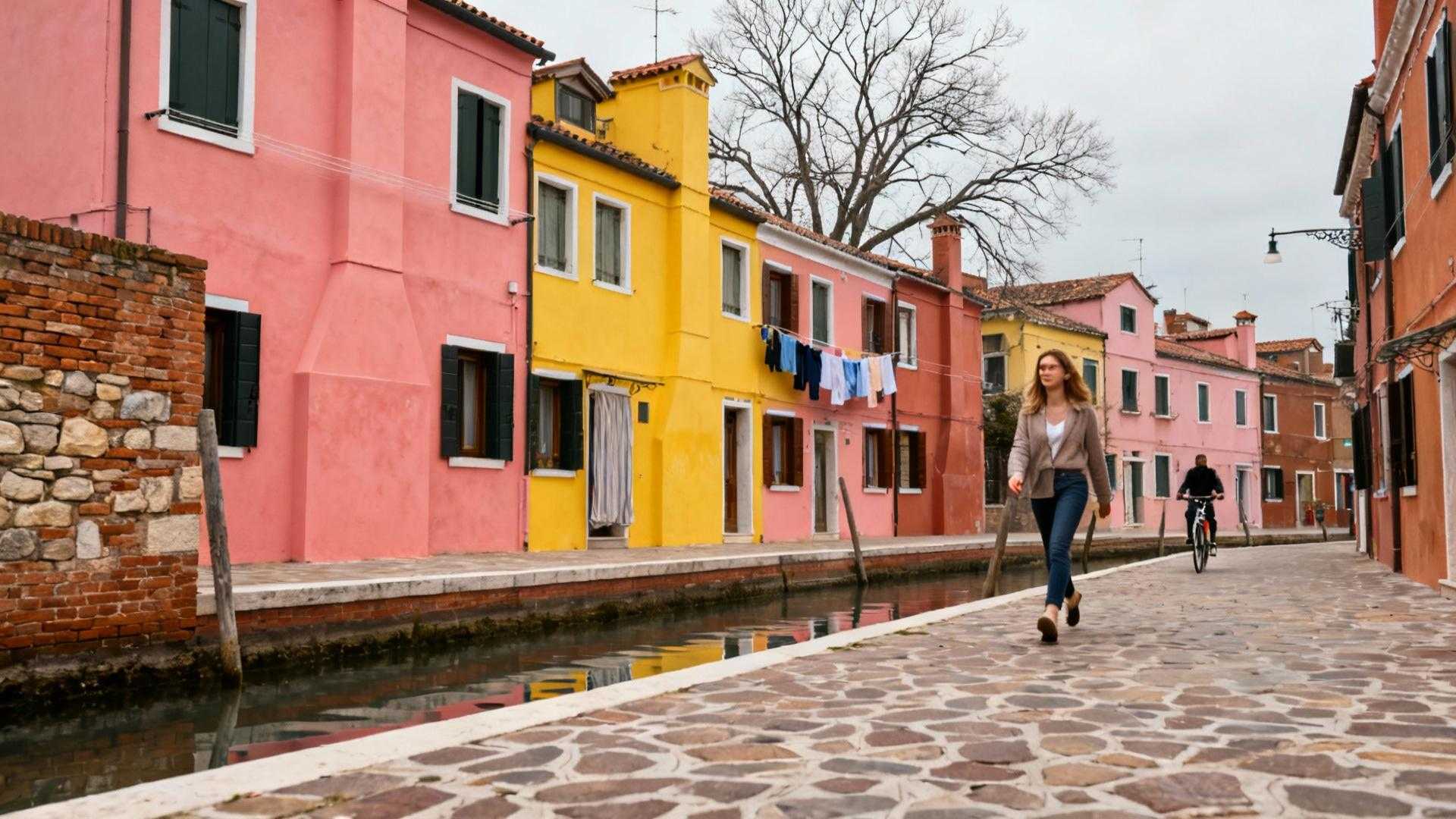I watched a fisherman repaint his house electric blue at dawn, mixing pigments under the watchful eye of Burano’s heritage council—a ritual repeated every two years across this 21-hectare island where 145 government-regulated color combinations protect a tradition born from fog, not fashion. This tiny Venetian lagoon sanctuary holds 2,700 residents who’ve transformed survival into art, turning what fishermen needed to navigate home through mist into Italy’s most photogenic secret, 40 minutes from Venice’s tourist chaos.
Burano isn’t accidental beauty. It’s bureaucratic poetry.
The intimate scale where every house tells a regulated story
Twenty-one hectares of protected color harmony
This island measures smaller than Vatican City yet packs 13,000 residents per square kilometer—the Venetian Lagoon’s densest community. I can walk its perimeter in 10 minutes, arms outstretched to touch opposite canal walls, yet spend days discovering how four interconnected islands merged into six sestieri (districts) where every facade requires municipal approval. The heritage council maintains a palette of 145 approved hues, rejecting paint proposals that clash with neighboring homes. One local showed me rejection letters—three attempts before his salmon pink satisfied harmony laws.
Government-controlled beauty costs zero euros to witness
While Venice charges €100+ for gondola experiences and entrance fees, Burano’s colorful streets remain free. The €30 vaporetto pass from Marco Polo Airport delivers unlimited 24-hour access to what locals call “L’Isola dei Merletti” (Island of Lace). I watched tourists pay €180 for Venice’s Doge’s Palace when Burano’s most vibrant landmark—Bepi Suà’s geometric-painted house—costs nothing but respectful photography. The municipal color system protects community identity without privatizing visual access, a democratic approach to heritage preservation Venice abandoned decades ago.
The fishermen’s fog navigation system that became Instagram legend
Five-hundred-year-old practicality painted over by beauty
Burano’s colors began as survival architecture in the 1500s. Fishermen working the lagoon needed to identify homes through dense morning fog that shrouded landmarks for hours. Each family claimed distinctive shades—cobalt blue, tangerine, rose—that functioned like maritime beacons before GPS existed. What started as pragmatic visibility became generational pride. The heritage council now enforces biennial repainting to maintain vibrancy, fining violators €5,000 for unauthorized color changes. I met a third-generation fisherman whose grandfather’s turquoise choice still guides his morning departures.
October’s golden hour recreates original fishermen atmosphere
Visit during shoulder season—specifically October’s 6:30am departures—when autumn mist recreates the fog that inspired this tradition. The vaporetto Line 12 cuts through morning haze as sunlight ignites facades in sequence: violet first, then coral, finally chrome yellow. Temperatures hover at 64°F (18°C), perfect for wandering without summer’s 32°C crowds that clog narrow alleys between 11am-2pm. Cruise ship invasions bypass early hours, leaving authentic community rhythms visible—laundry hung between rainbow walls, fishermen mending nets against fuchsia backdrops.
The lace-making heritage Venice commercialized but Burano protects
Sixteenth-century craft that supplied Milan Cathedral
Burano’s Lace Museum houses 500-year-old punto in aria technique once exported across Europe. While Venice converted craft into tourist trinkets, Burano maintains living workshops where artisans demonstrate needle lace under photography restrictions that protect sacred methods. Entry costs €8, but I found the same fierce cultural protection in Châtenois’s medieval fortifications—communities guarding identity against homogenization. Watch artisans’ hands blur through intricate patterns at Via Galuppi workshops, where €15 demonstrations reveal why machine-made lace can never replicate 200-hour handwork.
Locals balance tourism with tradition through council oversight
Maria, a 68-year-old lacemaker, explained: “The colors aren’t for tourists—they’re for us, our grandfathers, our children.” The heritage council’s approval process isn’t bureaucratic obstruction but community self-preservation. Unlike Tahiti’s privatized luxury that excludes locals, Burano’s regulations ensure residents control their island’s identity. Eighty percent of color requests pass review, but harmony matters more than trends.
The accessible alternative Venice’s chaos obscures
Forty minutes from Piazzale Roma without reservation madness
Board the vaporetto with no advance booking required—Burano operates on first-come convenience Venice abandoned. The €30 unlimited pass covers airport transfers, Murano glass detours, and Torcello’s Byzantine mosaics. I spent €15 on fresh seafood lunches versus Venice’s €45 tourist-trap pasta. The Ponte Longo bridge connects to Mazzorbo’s vineyards, offering escape when day-trippers arrive mid-morning. This accessibility democratizes discovery—no €200 water taxi monopolies, no reservation systems favoring wealthy travelers.
Cross-reference Croatia’s natural geometry for pattern contrast
If Burano proves man-made beauty benefits from systematic protection, Croatia’s heart-shaped Galesnjak demonstrates nature’s geometry needs no bureaucratic approval. Both destinations challenge mass tourism’s homogenizing effects—one through council-regulated repainting cycles, the other through geological coincidence locals fiercely protect from overdevelopment.
Questions about Burano’s color regulations and visiting logistics
How do residents obtain color approval for house repainting?
Homeowners submit paint proposals to Burano’s heritage council with color swatches and neighbor consultation records. The council reviews harmony with adjacent facades, approving 80% of requests within 30 days. Rejections include written explanations and alternative palette suggestions. Biennial repainting remains mandatory to maintain vibrancy standards.
What’s the best time to visit for authentic experience without crowds?
Dawn departures (6:30-8am) offer zero crowds and golden light. October through November provides shoulder-season pricing (€15 cheaper vaporetto passes), pleasant 64°F temperatures, and morning fog that recreates original fishermen atmosphere. Avoid 11am-2pm when cruise ship groups invade.
How does Burano differ from Venice proper culturally?
Burano maintains a 2,700-resident working community versus Venice’s tourist-only zones. Artisans preserve lace-making heritage, fishermen continue traditional practices, and heritage councils actively protect cultural identity. Costs run 70% lower—€15 lunches versus €45, free street access versus entrance fees.
